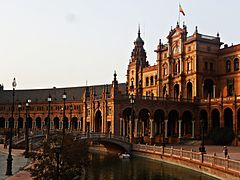Plaza de España (Seville)
| Plaza de España | |
|---|---|

Central building at the Plaza at sunset
|
|
| General information | |
| Architectural style | Spanish Regionalism, mixing Renaissance Revival in Spanish architecture and Art Deco within Neo-Mudéjar styles |
| Town or city | Seville |
| Country | Spain |
| Completed | 1928 |
| Client | Alfonso XIII |
| Technical details | |
| Floor area | 45,932 m2 (494,410 sq ft) |
| Design and construction | |
| Architect | Aníbal González |
The Plaza de España ("Spain Square", in English) is a plaza in the Parque de María Luisa (Maria Luisa Park), in Seville, Spain, built in 1928 for the Ibero-American Exposition of 1929. It is a landmark example of the Regionalism Architecture, mixing elements of the Renaissance Revival and Moorish Revival (Neo-Mudéjar) styles of Spanish architecture.
In 1929, Seville hosted the Ibero-American Exposition World's Fair, located in the celebrated Maria Luisa Park (Parque de María Luisa). The park gardens were designed by Jean-Claude Nicolas Forestier. The entire southern end of the city was redeveloped into an expanse of gardens and grand boulevards. The centre of it is Parque de María Luisa, a "Moorish paradisical style" with a half mile of tiled fountains, pavilions, walls, ponds, benches, and exhedras; lush plantings of palms, orange trees, Mediterranean pines, and stylized flower beds; and with vine hidden bowers. Numerous buildings were constructed in it for the exhibition.
The Plaza de España, designed by Aníbal González, was a principal building built on the Maria Luisa Park's edge to showcase Spain's industry and technology exhibits. González combined a mix of 1920s Art Deco and "mock Mudejar", and Neo-Mudéjar styles. The Plaza de España complex is a huge half-circle with buildings continually running around the edge accessible over the moat by numerous bridges representing the four ancient kingdoms of Spain. In the centre is the Vicente Traver fountain. By the walls of the Plaza are many tiled alcoves, each representing a different province of Spain.
Today the Plaza de España mainly consists of Government buildings. The central government departments, with sensitive adaptive redesign, are located within it. The Plaza's tiled Alcoves of the Provinces are backdrops for visitors portrait photographs, taken in their own home province's alcove. Towards the end of the park, the grandest mansions from the fair have been adapted as museums. The farthest contains the city's archaeology collections. The main exhibits are Roman mosaics and artefacts from nearby Italica.
...
Wikipedia
